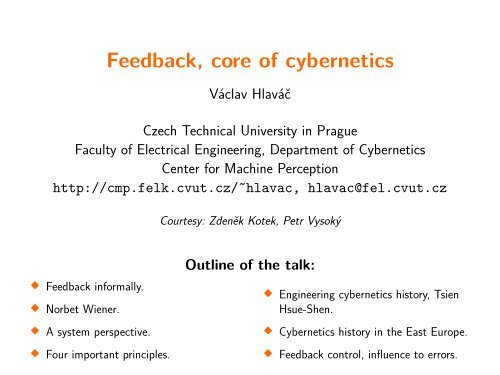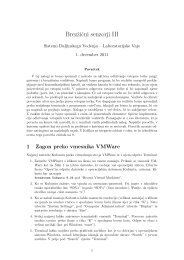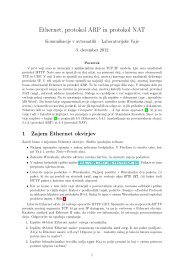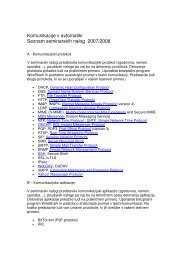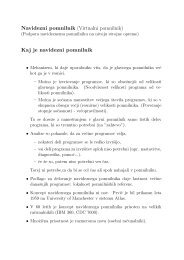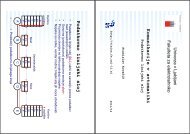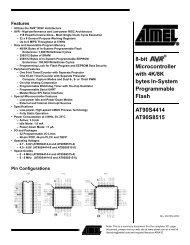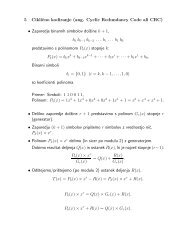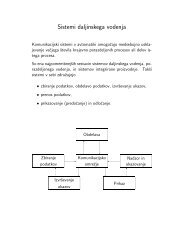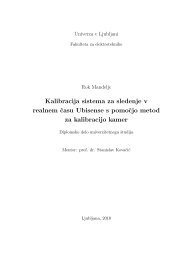Feedback, core of cybernetics - Center for Machine Perception ...
Feedback, core of cybernetics - Center for Machine Perception ...
Feedback, core of cybernetics - Center for Machine Perception ...
You also want an ePaper? Increase the reach of your titles
YUMPU automatically turns print PDFs into web optimized ePapers that Google loves.
<strong>Feedback</strong>, <strong>core</strong> <strong>of</strong> <strong>cybernetics</strong><br />
Václav Hlaváč<br />
Czech Technical University in Prague<br />
Faculty <strong>of</strong> Electrical Engineering, Department <strong>of</strong> Cybernetics<br />
<strong>Center</strong> <strong>for</strong> <strong>Machine</strong> <strong>Perception</strong><br />
http://cmp.felk.cvut.cz/˜hlavac, hlavac@fel.cvut.cz<br />
<strong>Feedback</strong> in<strong>for</strong>mally.<br />
Norbet Wiener.<br />
A system perspective.<br />
Four important principles.<br />
Courtesy: Zdeněk Kotek, Petr Vysoký<br />
Outline <strong>of</strong> the talk:<br />
<br />
<br />
<br />
Engineering <strong>cybernetics</strong> history, Tsien<br />
Hsue-Shen.<br />
Cybernetics history in the East Europe.<br />
<strong>Feedback</strong> control, influence to errors.
<strong>Feedback</strong>, introduction<br />
Merriam-Webster dictionary:<br />
1. The partial reversion <strong>of</strong> the effects <strong>of</strong> a process<br />
to its source or to a preceding stage.<br />
2. The transmission <strong>of</strong> evaluative or corrective<br />
in<strong>for</strong>mation about an action, event, or process to<br />
the original or controlling source;<br />
Also: the in<strong>for</strong>mation so transmitted.<br />
Unlike in modeling-based open-loop control<br />
<strong>of</strong> dynamic systems, the feedback weakens<br />
the need <strong>for</strong> precise models.<br />
Formalized by Norbert Wiener in 1948.<br />
The feedback concept is much older, though.<br />
Norbert Wiener<br />
1894 - 1964<br />
2/20
Steersman example<br />
Wind<br />
Port<br />
3/20
Steersman example<br />
Wind<br />
Port<br />
3/20
Steersman example<br />
3/20
Steersman example<br />
3/20
Steersman example<br />
3/20
Steersman example<br />
3/20
Steersman example<br />
3/20
Steersman example<br />
3/20
Steersman example<br />
3/20
Steersman example<br />
3/20
Steersman example<br />
3/20
Steersman example<br />
3/20
Steersman example<br />
3/20
Steersman example<br />
The name comes from the ancient Greek. Cybernetes means steersman.<br />
Becomes Governor in Latin.<br />
The term ‘cybernétique’ was used by French physicist André-Marie Ampère<br />
(1775–1836).<br />
3/20
Centrifugal Governor<br />
Boulton & Watt engine <strong>of</strong> 1788,<br />
look at the picture →<br />
J.C. Maxwell was the first who<br />
described the centrifugal governor<br />
mathematically.<br />
4/20
Norbert Wiener, 1894-1964<br />
His father Leo taught Slavic<br />
languages and German at<br />
Harvard University, was a friend<br />
<strong>of</strong> T.G. Masaryk.<br />
Norbert – a child prodigy.<br />
Bachelor in mathematics in 1909<br />
at the age <strong>of</strong> 14.<br />
PhD from Harvard University in<br />
1912 at the age <strong>of</strong> 17.<br />
His fame helped MIT to recruit a<br />
cognitive science team after<br />
WWII (psychology, mathematics,<br />
neurophysiology), including W.S.<br />
McCulloch and W. Pitts.<br />
<br />
<br />
<br />
Wiener filter, Cybernetics and<br />
many results in mathematics.<br />
Book: Cybernetics: Or Control<br />
and Communication in the<br />
Animal and the <strong>Machine</strong>. Paris,<br />
(Hermann & Cie) & Camb.<br />
Mass. (MIT Press), 1948.<br />
Autobiography:<br />
Ex-Prodigy: My Childhood and<br />
Youth. MIT Press, 1953<br />
I am a Mathematician. Gollancz,<br />
London, 1956. (the Czech<br />
translation exists: Můj život,<br />
Mladá Fronta 1970)<br />
5/20
A <strong>cybernetics</strong> perspective, a system<br />
The system system has the goal.<br />
The system acts, aims toward the goal.<br />
The environment affects the system and<br />
indirectly the aiming to the goal<br />
(situatedness).<br />
In<strong>for</strong>mation returns to the system – the<br />
‘feedback’.<br />
• The system measures the difference<br />
between the current ‘state’ and the<br />
goal (error).<br />
• The system corrects the action to aim<br />
towards the goal.<br />
• This process is repeated.<br />
System<br />
Measurement<br />
<strong>Feedback</strong><br />
Environment<br />
Goal<br />
Effect<br />
Action<br />
6/20
Benefits <strong>of</strong> the feedback:<br />
<br />
<br />
<br />
<br />
<br />
A feedback control loop<br />
Reduces error (eliminates the error in some cases).<br />
Reduces sensitivity, enhances robustness, reduces uncertainty.<br />
Eliminates or removes disturbances.<br />
Improves the dynamic per<strong>for</strong>mance or adjusts the transient response.<br />
Allows stabilizing systems which are unstable otherwise.<br />
7/20
Governing without feedback is possible too<br />
Jackquard loom, example<br />
<br />
<br />
<br />
Invented by Joseph Marie Jacquard,<br />
first demonstrated in 1801.<br />
Revolutionized production <strong>of</strong><br />
complex patterns on textiles.<br />
Programmable device by collection<br />
<strong>of</strong> punch cards.<br />
1840, Museum Česká Skalice<br />
8/20
Four most important principles <strong>of</strong> <strong>cybernetics</strong> (1)<br />
<br />
<br />
<strong>Feedback</strong> was intuitively used already in antiquity. Founders <strong>of</strong> <strong>cybernetics</strong><br />
claimed that the feedback is a very general principle spanning technology,<br />
biology, astronomy, economics, etc.<br />
In<strong>for</strong>mation.<br />
• The first systematic description is by C. Shannon’s entropy (1948). It<br />
says that in<strong>for</strong>mation equals the amount <strong>of</strong> eliminated uncertainty<br />
which is described probabilistically.<br />
• The Kolmogorov-Solomon<strong>of</strong>f complexity (1966) length <strong>of</strong> the string<br />
(∼ program) explaining the data, also called minimum description<br />
length principle.<br />
Recommended reading <strong>for</strong> Czech students:<br />
P. Vysoký: Padesát let kybernetiky, Od jednotného oboru logických pozitivistů<br />
k mnoha specializacím. Vesmír, Vol. 77, November 1998, pp. 626-633.<br />
9/20
Four most important principles <strong>of</strong> <strong>cybernetics</strong> (2)<br />
<br />
<br />
Model.<br />
• The idea is that there are isomorphism between different systems, e.g.,<br />
mechanical, hydraulic, electrical, which can be described by the same<br />
differential equations.<br />
• Modeling allows studying phenomena by thought experiments in<br />
different time, space scale or by physical experiments with realizable<br />
models.<br />
Law <strong>of</strong> Requisite Variety: “variety absorbs variety, defines the minimum<br />
number <strong>of</strong> states necessary <strong>for</strong> a controller to control a system <strong>of</strong> a given<br />
number <strong>of</strong> states.” by W.R. Ashby (1903-1972), the English psychiatrist.<br />
This law can be applied <strong>for</strong> example to the number <strong>of</strong> bits necessary in a<br />
digital computer to produce a required description or model.<br />
10/20
The Law <strong>of</strong> Requisite Variety<br />
Control is most fundamentally <strong>for</strong>mulated<br />
as a reduction <strong>of</strong> variety: perturbations with<br />
high variety affect the system’s internal<br />
state, which should be kept as close as<br />
possible to the goal state, and there<strong>for</strong>e<br />
exhibit a low variety.<br />
Control prevents the transmission <strong>of</strong> variety<br />
from environment to system.<br />
This is the opposite <strong>of</strong> in<strong>for</strong>mation<br />
transmission, where the purpose is to<br />
maximally conserve variety.<br />
In response, Roger C. Conant 1970 “Good<br />
Regulator theorem”: Every Good Regulator<br />
<strong>of</strong> a System Must be a Model <strong>of</strong> that<br />
System.<br />
William R. Ashby<br />
(1903-1972)<br />
11/20
Scope <strong>of</strong> <strong>cybernetics</strong> (outside <strong>of</strong> technology)<br />
Explanation <strong>of</strong> communication = psychology.<br />
Modeling <strong>of</strong> learning = cognitive science.<br />
Limits <strong>of</strong> knowing = epistemology.<br />
Hearer makes the meaning = post-modernism.<br />
Reality as a social construction = constructivism.<br />
Reliable methodologies <strong>of</strong> describing = science.<br />
Measuring understanding & agreement<br />
= science <strong>of</strong> subjectivity,<br />
= second-order <strong>cybernetics</strong>.<br />
12/20
Engineering <strong>cybernetics</strong>, Tsien Hsue-Shen (1)<br />
Another transcription <strong>of</strong> the name: Qian<br />
Xuesen (1911-2009).<br />
MSc. in Mechanical Engineering in China,<br />
1935 left China to USA, MSc. from MIT<br />
1936.<br />
PhD from Caltech under Theodore von<br />
Kármán in 1939, member <strong>of</strong> the ‘Suicide<br />
squad’ – built rockets with a colleague PhD<br />
student Frank Malina.<br />
Suicide squad was moved to Pasadena. Jet<br />
Propulsion Laboratory was created in 1943<br />
there.<br />
Frank Malina,<br />
WAC Corporal Rocket, Oct 1945.<br />
Tsien Hsue-Shen in 1939<br />
13/20
Engineering <strong>cybernetics</strong>, Tsien Hsue-Shen (2)<br />
After the WWII, he investigated German<br />
scientists including Werner von Braun.<br />
His 800 pages report summarizing German<br />
results became the classified Bible <strong>of</strong> the<br />
US rocket and space programs.<br />
Became the first director <strong>of</strong> JPL in 1949.<br />
McCarthyism put him into hause arrest<br />
from 1950-1955. After, he left <strong>for</strong> China.<br />
He wrote the textbook: Engineering<br />
Cybernetics, McGraw-Hill 1954, 289 p.<br />
Ludwig Prandl, Tsien Hsue-Shen,<br />
T. von Kármán, 1945<br />
Leaving USA 1955<br />
14/20
Engineering <strong>cybernetics</strong>, Tsien Hsue-Shen (3)<br />
His book was warmly received in Eastern<br />
Europe and China.<br />
The book introduced a practical view on<br />
servomechanisms and their control.<br />
The book is a source <strong>of</strong> the discipline name<br />
“Technical Cybernetics” used in the East.<br />
Tsien became the father <strong>of</strong> the Chinese<br />
ballistic missile program as well as the<br />
Chinese space program.<br />
Someone noted when he was about to leave<br />
the USA that he is worth 2 army divisions.<br />
It was an obvious underestimate :-)<br />
Tsien Hsue-Shen,<br />
with Mao, 1956<br />
Tsien’s Chinese Rockets<br />
15/20
Cybernetics in the Soviet Union<br />
Under Stalin: Outlawed as bourgeois<br />
pseudoscience, “mechanistically equating<br />
processes in live nature, society and in technical<br />
systems, and thus standing against materialistic<br />
dialectics and modern scientific physiology<br />
developed by Ivan Pavlov”.<br />
Arnošt (Ernst) Kolman (1892-1979), a Czech<br />
marxist philosopher with a cosmopolitan life,<br />
published the paper “What is <strong>cybernetics</strong>” in<br />
the Russian journal Voprosy Filos<strong>of</strong>ii in 1955.<br />
Alexei Lyapunov (1911-1973) and Victor<br />
Glushkov (1923-1982), both pioneers <strong>of</strong> Soviet<br />
Computer Science, helped legitimation <strong>of</strong><br />
Cybernetics in the Eastern Block.<br />
A. Lyapunov promotes<br />
cybernetization.<br />
Arnošt Kolman<br />
16/20
Cybernetics in Czechoslovakia, two Zdeněk’s<br />
Pr<strong>of</strong>. Zdeněk Trnka (1912-1968) from the<br />
Czech Technical University in Prague started<br />
teaching servomechanisms in 1950s. He learned<br />
it in his post-war sabbatical in the USA.<br />
He also helped to create a laboratory in the<br />
Czechoslovak Academy <strong>of</strong> Sciences which later<br />
trans<strong>for</strong>med to the current Institute In<strong>for</strong>mation<br />
Theory and Automation (ÚTIA).<br />
Pr<strong>of</strong>. Zdeněk Kotek (1924-2004), the student <strong>of</strong><br />
Zdeněk Trnka, led the <strong>cybernetics</strong> ef<strong>for</strong>t at the<br />
Czech Technical University in Prague <strong>for</strong> many<br />
years. He was the founder and the head <strong>of</strong><br />
Department <strong>of</strong> Control Engineering in<br />
1959-1989. His own research field was the<br />
non-linear control.<br />
Zdeněk Trnka<br />
Zdeněk Kotek<br />
17/20
Error and overshoot<br />
Error: The difference in the<br />
current state and desired state <strong>of</strong><br />
the system.<br />
Zero/non-zero error: Tells<br />
whether there is an error or not.<br />
The least in<strong>for</strong>mation we could<br />
have.<br />
Direction <strong>of</strong> error: Which way to<br />
go to minimize the error<br />
<br />
<br />
Magnitude <strong>of</strong> error: The distance<br />
to the goal state.<br />
Overshoot:<br />
• The state goes beyond its set point<br />
(e.g., position) or changes<br />
direction be<strong>for</strong>e stabilizing on it.<br />
• Control is much easier if we know<br />
both magnitude and direction.<br />
18/20
Controllers, oscillations, damping<br />
Basic feedback controllers<br />
<br />
<br />
<br />
<br />
P: proportional control.<br />
PI: proportional integral control.<br />
PD: proportional derivative control.<br />
PID: proportional integral derivative control.<br />
19/20
model <strong>of</strong><br />
the world<br />
cognitive module<br />
<strong>Feedback</strong>s in a cognitive robot<br />
planner<br />
goal<br />
perception<br />
cognitive<br />
feedback<br />
action module<br />
plan<br />
realizer<br />
selection<br />
and data<br />
processing<br />
operational<br />
feedback<br />
sensoric module<br />
efectors<br />
sensors<br />
reflexive<br />
feedback<br />
outside<br />
world<br />
20/20


